OF BULBS, BULBILS, BULBLETS, AND CORMS
Admission
I’ve admitted to this addiction before and I’ll do it again. I’ll even hope you become addicted. You are forewarned.
My addiction is to propagating plants. No harm done, you say? How about all the plants that you become inundated with. Perhaps you plant them; that can be overdone. Give them away, please. Or sell them.
Anyway, here goes another wrinkle on plant propagation. You are forewarned!
What’s in Your Hand?
You’ve perhaps bought some spring flowering bulbs for planting. Wait! Before you drop all those tulip, daffodil, crocus, and hyacinth bulbs into holes in the ground, put a few aside for multiplying your holdings. Sure, they’ll multiply by themselves, but you could speed up the process.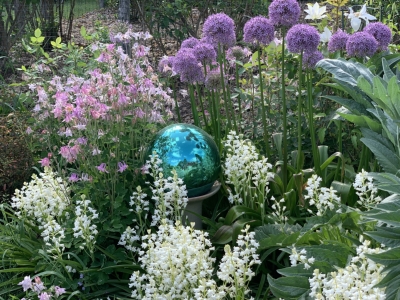
Before you can multiply a bulb, ask yourself, “Is this really a bulb that I’m holding?” Some so-called bulbs, such as crocus and gladiolus, are in fact corms. A corm is just a thickened hunk of stem with a compressed area of growing points, which might include flower buds.

Sprouting corm
If you want crocuses to multiply prolifically, make cuttings, just as you would with any stem. Each cutting needs at least one bud, or eye, best seen on a corm by removing the papery covering. Because of all this wounding and the difficulty of seeing the eyes (of the corm) this time of year, you could delay this process until early spring. Then, wounds heal most quickly and eyes are plumping up.
Corms can also be propagated another way, with cormels. As the name suggests, these are baby corms, and they’re produced around the base of a corm. Plant your crocus shallower than recommended and you’ll get more cormels. Flick them off and give each space to grow.
Many Ways with Bulbs
Most other common spring bulbs are true bulbs, consisting of a flattened piece of stem with the bulk of the bulb made up of leaves, scales, or both. Just as with your forsythia or rose bush, buds grow wherever leaves meet a stem. In bulbs, these buds become bulblets, which grow up to become first offsets and then bona fide bulbs themselves.
One way to multiply bulbs is to dig them up sometime between early summer and now, then snap off and plant out the offsets. Not having to elbow around in the dirt with their mother bulb, bulblets, or other offsets lets these separated offsets grow quickly to flowering size — and make more of their own bulblets and offsets.
For greater increase, make bulb cuttings. Perform this operation by slicing a bulb from top to bottom into 8 or so vertical sections, each with a piece of the base.

Sprouting corms
Plant the cuttings in a shallow container covered with enough potting soil so only the tips show, and keep the potting soil moist and at room temperature. Bulblets will form at the base of each cutting.
Yet another way to increase the number of bulblets — especially useful with hyacinths, which are naturally shy multipliers — is with cuttage. Turn the bulb upside down and score it through its center, dividing the base into 6 pie shaped sections.
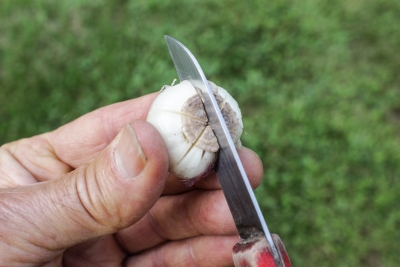
Alternatively, scoop out the base with a knife. 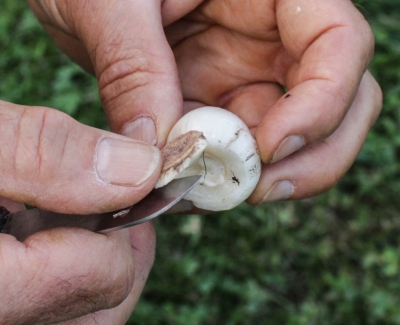 Either way, you will have nipped out the growing point within, letting side “shoots”, i.e. bulblets, grow, just like when you make any stem more bushy by nipping out its top bud. Replant the bulb, then reap your bulblet harvest next year.
Either way, you will have nipped out the growing point within, letting side “shoots”, i.e. bulblets, grow, just like when you make any stem more bushy by nipping out its top bud. Replant the bulb, then reap your bulblet harvest next year.
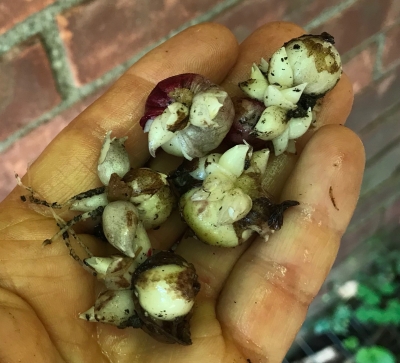
Hyacinth bulblets after 1 season
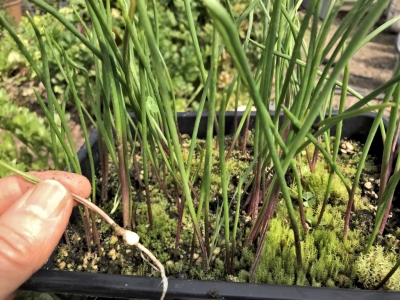
Bulblets nursed in a container
Lily is a bulb with naked scales, and a few of these scales can be flicked off a mother bulb for rooting. Just take a few, so enough scales are left to nourish the mother bulb when you replant it. 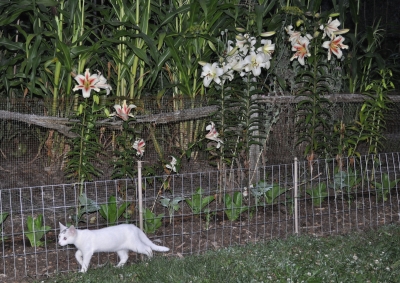
Toss the scales into a bag with some moist perlite and keep the bag at room temperature. After 6 to 12 weeks, move the bag into the refrigerator until early spring, when you’re ready to plant. Expect 3 to 5 bulblets to form at the base of each scale.
Some lilies also grow bulbils, tiny, secondary bulbs, in the axes of their leaves. These can also be flicked off and planted.
Another bulb with naked scales is crown imperial, whose flowering shoot is capped in spring by a crown of leaves below which dangle a ring of red flowers (yellow in some varieties). 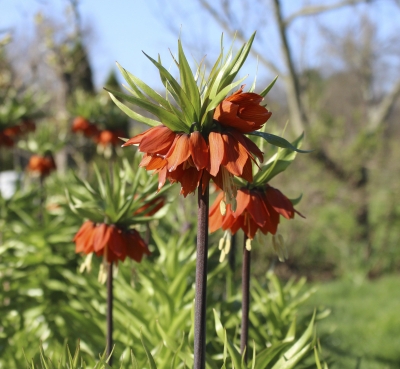 Despite, or because of, its skunky aroma, as well as its ten dollar or more cost per bulb, I started propagating this bulb a few years ago and now have them planted everywhere. Bulblets even formed from random pieces of bulb scale.
Despite, or because of, its skunky aroma, as well as its ten dollar or more cost per bulb, I started propagating this bulb a few years ago and now have them planted everywhere. Bulblets even formed from random pieces of bulb scale.
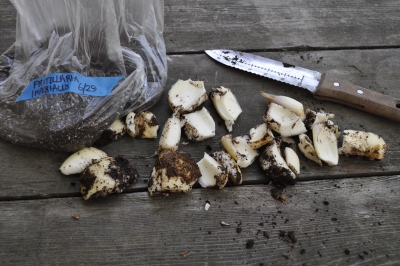
Cut up leaf scales of crown imperial
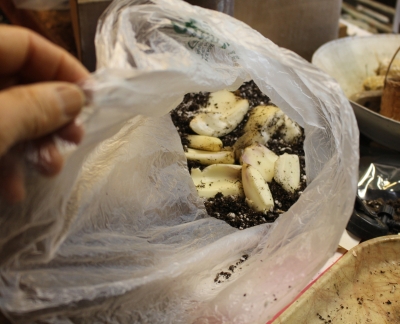
Pieces in bag with potting soil
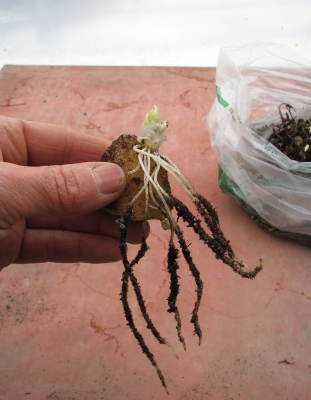
Sprouting roots
Now, Patience
When propagating bulbs, just as when propagating any plant, the next step is waiting. The time for your new “bulbs” to reach flowering size depends on the kind of bulb and the method of propagation: a year for a daffodil offset, a couple of years for a crocus cormel, or lily or crown imperial scale, 3 or 4 years for hyacinths bulblets.
Setting aside a nursery row is the best way to manage digging and keeping track of these plants. Yes, multiplying bulbs does take some trouble and time, but you end up with oodles of plants. And this parenting is fun.
(This post was adapted from my book, The Ever Curious Gardener: Using a Little Natural Science for a Much Better Garden, available here.)
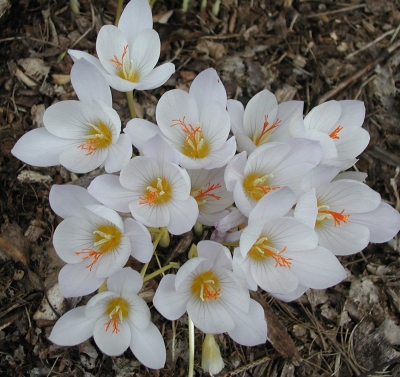




Hey Lee, much appreciated for your very hand-on posts, I love it!
Question for the hyacynth bulblets: you said you cut them and replant them in the ground. At what time is it advised to do so? Do you reckon it would be ok to do it now in Summer season?
I’ve read some scientific article saying that Early/mid July is ideal, but just checking what’s working for you!
Thanks and keep going!
That timing should be okay although sometimes I like to put bulblets in pots with potting soil so that I can nurse them till they grow bigger. Not if I have lots and lots of them though.